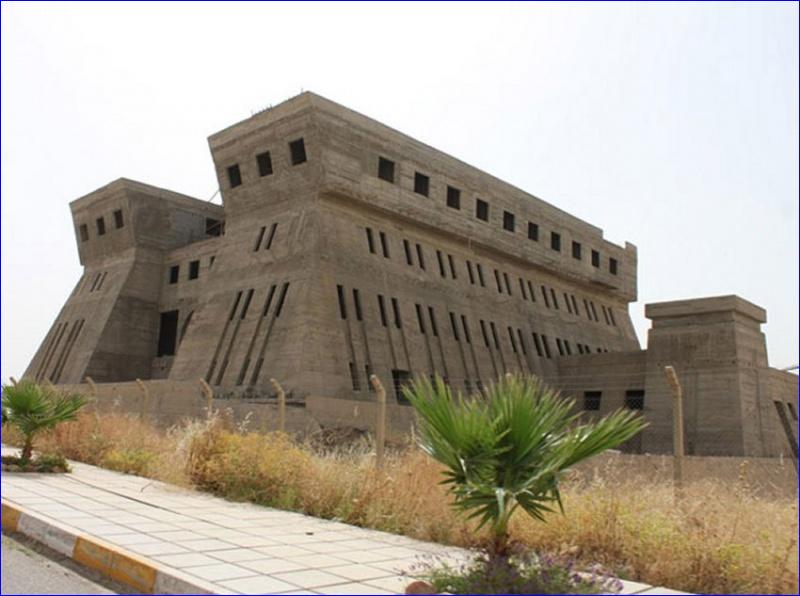


This library was one of the victims of the war and the fighting between the Islamic State and the Iraqi forces and Popular Mobilisation Forces. The library stopped operating in 2014.
Work to revive the library began in 2001, two years before the US-led invasion of Iraq. Construction of the library building had been completed but the project was hamstrung by the invasion. It resumed in 2004 thanks to an initiative by the State University of New York at Stony Brook, which donated more than 1,000 books and periodicals.
The library also received books from the British Institute for the Study of Iraq and other archaeological institutes but was generally neglected and probably remains near the bottom of the list of Mosul University's reconstruction concerns.
"The reconstruction of the Assyrian library cannot be started because there are other priorities," said Thaer al-Samman, dean of the Faculty of Management and Economics at Mosul University. "The central library was destroyed and burned. The old and new university presidency buildings, as well as the internal departments, were destroyed by rockets. The Engineering School, the Veterinarian Sciences and the Medical Sciences schools, as well as the university hospitals, were razed.
"Clearing the rubble has just begun. The University Press was also burned and its equipment looted. Not a single stone was left intact," Samman said. "As for the Faculty of Management and Economics, its ground floors had been burned and reconstruction work was completed just two days before this year's Eid al-Adha. It is clear from all of this that rebuilding the Assyrian library will be quite late."
A British expedition in the mid-19th century at the Kouyunjik site in Nineveh governorate discovered 26,000 clay tablets inscribed in Akkadian that dated to the seventh century BC. The discovery was made at the site of the palace of the last ruler of the Assyrian empire, Ashurbanipal.
The royal palace was burned when the ancient Assyrian city of Nineveh was destroyed in 612BC. The library contained important texts owned by King Ashurbanipal, such as accounts of wars, letters and treaties. They were catalogued in five volumes kept at the British Museum in London.
Ibrahim Khalil al-Allaf, professor of modern history at the University of Mosul, said he had appealed to the Iraqi Ministry of Higher Education and Scientific Research, Mosul University and other authorities, including the Council of Ministers and the prime minister, to consider completing construction of the library. He said the operation would not require much money.
He said UNESCO could be called upon to rehabilitate the library and open it to researchers. Allaf said many entities inside and outside Iraq, including the Bibliotheca Alexandrina in Egypt, expressed a willingness to cooperate and provide the library with sources and references.
The Egyptian initiative sought to outfit the Ashurbanipal Library with 100,000 books by having Mosul University solicit contributions from Arab scientific and academic institutions. The organisations contacted were the UAE Juma al-Majid Centre for Culture and Heritage, the Sultan Ali Owaiys Foundation and the Saudi Umm al-Qura University.
A source in the Ministry of Higher Education and Scientific Research said the University of Mosul adopted the project in 2001 to transform the library into a specialised hub servicing researchers and specialists in Iraqi history and monuments, organising conferences and scientific seminars and the publication of specialised books and scientific journals.
The source said work on the project was proceeding as scheduled and continued after 2003 until the Islamic State occupied Mosul.
The University of Mosul designed the large library building using elements and motifs characteristic of Assyrian architecture such as the winged bull, towers, corniced balconies, arches and terraces. While waiting for the construction to be completed, the university's central library dedicated part of its ground floor to a temporary unit.
The Ashurbanipal Library consisted of five floors, two of which were underground and dedicated to storage of books and other materials. Plans called for the ground floor to have halls for seminars and conferences, display rooms for artefacts from the various periods of Iraq's history spanning the Sumerian, Akkadian, Babylonian, Assyrian, pre-Islamic and the different Islamic eras and rooms for displaying duplicates of the original cuneiform texts kept at the British Museum.
Mosul University professors urged government agencies to seek the help of international cultural organisations to complete the Ashurbanipal Library project. Museums and universities in Britain, Germany and the United States have said they would provide the library with materials related to the Ashurbanipal era.

or register to post a comment.